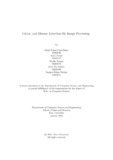| dc.contributor.advisor | Karim, Dewan Ziaul | |
| dc.contributor.author | Chowdhury, Mahir Faisal | |
| dc.contributor.author | Nondi, Amit | |
| dc.contributor.author | Zaman, Fardin | |
| dc.contributor.author | Akhter, Sium Ibn | |
| dc.contributor.author | Pathan, Tanjina Bilma | |
| dc.date.accessioned | 2024-05-09T03:08:19Z | |
| dc.date.available | 2024-05-09T03:08:19Z | |
| dc.date.copyright | ©2024 | |
| dc.date.issued | 2024-01 | |
| dc.identifier.other | ID: 19301026 | |
| dc.identifier.other | ID: 19101247 | |
| dc.identifier.other | ID: 20301473 | |
| dc.identifier.other | ID: 20101566 | |
| dc.identifier.other | ID: 19101617 | |
| dc.identifier.uri | http://hdl.handle.net/10361/22781 | |
| dc.description | This thesis is submitted in partial fulfillment of the requirements for the degree of Bachelor of Science in Computer Science, 2024. | en_US |
| dc.description | Cataloged from PDF version of thesis. | |
| dc.description | Includes bibliographical references (pages 49-51). | |
| dc.description.abstract | Citrus leaf diseases bring a danger to the earnings of citrus estates. When it comes
to recovering from illness, early detection and accurate diagnosis are very necessary.
In the last several decades, there have been advancements made in the diagnosis and
classification of citrus leaf diseases via the use of deep learning techniques in image
processing. When it comes to automating the detection of citrus leaf diseases, we
recommend making use of pre-trained convolutional neural networks (CNNs) like
ResNet-50, VGG16, MobileNet-V2, InceptionV3, InceptionResNet-V2, DenseNet-
201, and DenseNet-121.To accomplish this goal, a comprehensive data collection
consisting of images of citrus leaves that have been identified will be gathered and
pre-processed. Citrus canker, greening, and black spot leaves will be included in
the databases, along with healthy and diseased citrus leaves.For the purpose of extracting
useful characteristics from leaf images, we shall make use of deep learning
models. For the purpose of picture classification, the models that were discussed
before are useful and often used.In this research, we propose a CNN model that is
both effective and efficient. The model was originally trained on 596 pictures, and
then it was augmented with 2800 images that were divided into three categories:
training, validation, and testing.70% of the data goes towards training, 15% goes
towards validation, and 15% goes towards testing.A few pieces of public data will
be served this model.Following that, we will evaluate the findings in relation to the
prebuilt models.Last but not least, we get a training accuracy of 95.95% and a validation
accuracy of 97.84%. Furthermore, our suggested model has a lower number
of training parameters compared to all other pretrained models, which enables our
model to categorise illnesses more quickly.This provides us with a decent level of
accuracy. | en_US |
| dc.description.statementofresponsibility | Mahir Faisal Chowdhury | |
| dc.description.statementofresponsibility | Amit Nondi | |
| dc.description.statementofresponsibility | Fardin Zaman | |
| dc.description.statementofresponsibility | Sium Ibn Akhter | |
| dc.description.statementofresponsibility | Tanjina Bilma Pathan | |
| dc.format.extent | 63 pages | |
| dc.language.iso | en | en_US |
| dc.publisher | Brac University | en_US |
| dc.rights | Brac University theses are protected by copyright. They may be viewed from this source for any purpose, but reproduction or distribution in any format is prohibited without written permission. | |
| dc.subject | Deep learning | en_US |
| dc.subject | CNN | en_US |
| dc.subject | ResNet-50 | en_US |
| dc.subject | VGG16 | en_US |
| dc.subject | MobileNet-V2 | en_US |
| dc.subject | InceptionResNet-V2 | en_US |
| dc.subject | DenseNet-121 | en_US |
| dc.subject.lcsh | Machine learning | |
| dc.subject.lcsh | Image processing--Congresses | |
| dc.title | Citrus leaf disease detection by image processing | en_US |
| dc.type | Thesis | en_US |
| dc.contributor.department | Department of Computer Science and Engineering, Brac University | |
| dc.description.degree | B.Sc. in Computer Science | |

